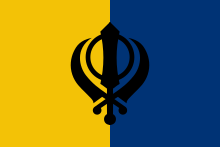Khalistan movement
Khalistan (Punjabi: ਖਾਲਿਸਤਾਨ, "pure land"), also Sikh Republic of Khalistan or Sikh Holy Kingdom of Khalistan, is the idea, emerging from the early 20th century, of a nationalist movement among Sikhs to establish an independent state in India and Pakistan, encompassing present-day Punjab and surrounding areas.
Khalistan emerged as an insurgency movement around other religious nationalist groups opposed to the British colonial administration. The project of a nation-state based on theocratic and democratic principles was named by Jagjit Singh Chauhan.
The separatist movement for the establishment of Khalistan reached its peak in India in the 1980s and has since lost considerable momentum, although limited support for it still exists in expatriate Sikh circles. Prior to the terrorist attack on Air India Flight 182, Khalistan had enjoyed considerable support among sections of North American Sikhs. The Khalistan movement is now seen mainly as an insignificant separatist movement supported primarily by Sikhs not living in Punjab. Existing pro-Khalistan groups are monitored by European and American governments.
Among the political proponents of the idea in the United States at one time were politicians Dan Burton, Jesse Helms and Edolphus Towns. Other sympathizers include Eric Lubbock, 4th Baron Avebury, and Lord Nazir Ahmed of the United Kingdom, as well as the late General Muhammad Zia-ul-Haq, Chief of Staff of the Pakistan Army and President of Pakistan.
The Sikh ruler Maharaja Ranjit Singh (d. 1839), a secular and religiously tolerant monarch within limits, ruled an independent Sikh kingdom in the 19th century with Lahore as its capital. In 1849, his empire was annexed and made part of the British Empire. According to the Treaty of Amritsar, the territory should have been returned to the monarchy once a member of the ruling family named Duleep Singh reached the age of majority. Nevertheless, it is widely regarded as irrelevant and its political exploitation by the Khalistan Movement is rejected.
The violent struggle for independence reached its peak in the 1980s, when the Indian army stormed the Golden Temple in 1984 in Operation Blue Star. As a result, Prime Minister Indira Gandhi was assassinated by her Sikh bodyguards. In 1986, Arun Vaidya, who was the Indian Army chief in Operation Blue Star, was assassinated by Harjinder Singh Jinda, Sukhdev Singh Sukha and Ranjit Singh Gill. Pakistan's ISI intelligence agency conducted Operation K2 in the 1990s in the hope of seceding both Kashmir and Punjab from India and annexing them to Pakistan.

Flag of Khalistan
Questions and Answers
Q: What is the Khalistan movement?
A: The Khalistan movement is a Sikh secessionist movement that seeks to create an independent homeland for Sikhs by seceding the Indian Punjab from India and establishing a sovereign, ethno-religious Sikh state called Khālistān ('Land of the Khalsa').
Q: What is the goal of the Khalistan movement?
A: The goal of the Khalistan movement is to create a homeland for Sikhs by seceding the Indian Punjab from India and establishing a sovereign, ethno-religious Sikh state called Khālistān ('Land of the Khalsa'), in the Punjab region.
Q: When was Khalistani independence declared?
A: Khalistani separatists declared their unilateral independence from India on 29 April 1986.
Q: Who declared Council of Khalistan?
A: Jagjit Singh Chauhan declared Council of Khalistan at Anandpur Sahib on 12 April 1980.
Q: Who were President and Secretary General of organization?
A: Jagjit Singh Chauhan was President and Balbir Singh Sandhu was Secretary General.
Q: Where did Chauhan announce formation of Khalistan?
A: Chauhan announced formation of Khalistan in London in May 1980, while Sandhu made similar announcement in Amritsar.
Q: How long did period violence last during this movement?
A:The period violence, militancy, and terrorism associated with this movement lasted from 1980s to mid-1990s.
Search within the encyclopedia